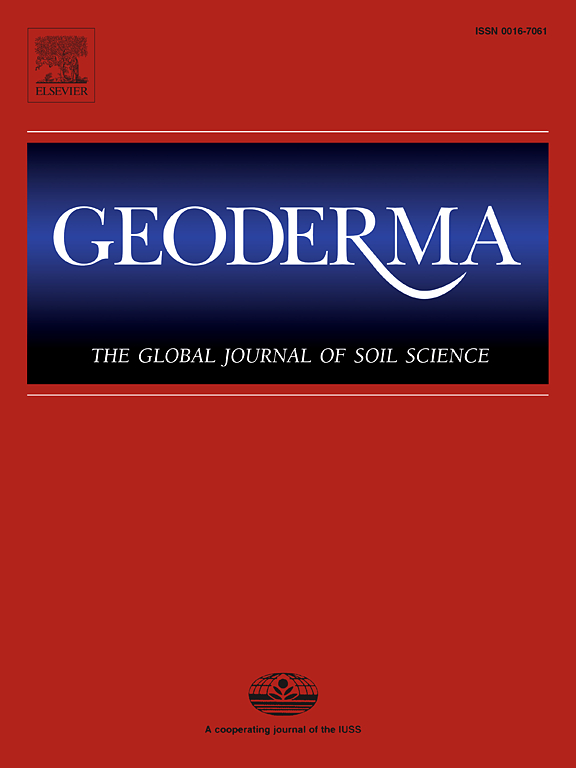A simple pedotransfer function to estimate fine fraction organic carbon contents of surface horizons in French soils
IF 6.6
1区 农林科学
Q1 SOIL SCIENCE
引用次数: 0
Abstract
It has been proposed to separate soil organic carbon (SOC) into two physical fractions, i.e., fine fraction organic carbon (OCfine) and coarse fraction organic carbon, to improve our ability to understand controlling factors and predict SOC contents and SOC stability. In this study, we aimed at building a simple pedotransfer function to estimate OCfine content measured using a size fractionation protocol in French soils. We define OCfine as SOC content measured in the < 50 µm fraction. We used information from the French Soil Quality Monitoring Network (RMQS, 706 observations) and from a literature search (245 observations) to build and validate the pedotransfer function. We used the Random Forest algorithm and partial dependence plots in an exploratory data analysis, to analyze the variables influencing OCfine contents and to study the shape of their relationship with OCfine. Using the knowledge gained from the exploratory analysis, we constructed a simple pedotransfer function. A slight inflection in the OCfine content was detected with increasing SOC content and a good approximation of OCfine content was reached using a second-degree polynomial relationship, with distinct coefficients depending on the land cover (i.e., croplands and permanent crops, grasslands, natural grasslands, and forests and shrubs). A cross-validation of the pedotransfer function led to an RMSE of 2.2 g kg−1 and an independent validation led to an RMSE of 2.0 g kg−1. The domain of applicability of the pedotransfer function was defined as being restricted to topsoil horizons and a SOC content ≤ 90 g kg−1. The estimated OCfine is deemed equivalent to a measure after a complete soil dispersion and a size fractionation protocol. The proposed pedotransfer function could be easily used in future soil carbon modeling frameworks. From a land management perspective, the shape of the relationship found between SOC and OCfine encourages increasing SOC levels to store more carbon in soil, including in the OCfine fraction.
估算法国土壤表层精细有机碳含量的简单土壤传递函数
提出将土壤有机碳(SOC)划分为两个物理组分,即细组分有机碳(OCfine)和粗组分有机碳(粗组分有机碳),以提高我们对土壤有机碳含量和稳定性的控制因素的认识和预测能力。在这项研究中,我们旨在建立一个简单的土壤传递函数,以估计在法国土壤中使用尺寸分馏协议测量的OCfine含量。我们将OCfine定义为在<中测量的SOC含量;50µm分数。我们使用来自法国土壤质量监测网络(RMQS, 706个观测值)和文献检索(245个观测值)的信息来构建和验证土壤传递函数。我们在探索性数据分析中使用随机森林算法和偏相关图来分析影响OCfine含量的变量,并研究它们与OCfine之间的关系。利用从探索性分析中获得的知识,我们构造了一个简单的土壤传递函数。随着有机碳含量的增加,OCfine含量有轻微的变化,并且利用二阶多项式关系可以很好地近似OCfine含量,并且根据土地覆盖(即农田和永久作物,草地,天然草地,森林和灌木)具有不同的系数。交叉验证的土壤传递函数的RMSE为2.2 g kg - 1,独立验证的RMSE为2.0 g kg - 1。土壤传递函数的适用范围限定在表层土层和有机碳含量≤90 g kg−1。估计的OCfine被认为是在完全的土壤分散和尺寸分馏协议之后的一个测量。所提出的土壤传递函数可以很容易地用于未来的土壤碳模型框架。从土地管理的角度来看,有机碳和有机碳之间的关系鼓励提高有机碳水平,以在土壤中储存更多的碳,包括在有机碳分数中。
本文章由计算机程序翻译,如有差异,请以英文原文为准。
求助全文
约1分钟内获得全文
求助全文
来源期刊

Geoderma
农林科学-土壤科学
CiteScore
11.80
自引率
6.60%
发文量
597
审稿时长
58 days
期刊介绍:
Geoderma - the global journal of soil science - welcomes authors, readers and soil research from all parts of the world, encourages worldwide soil studies, and embraces all aspects of soil science and its associated pedagogy. The journal particularly welcomes interdisciplinary work focusing on dynamic soil processes and functions across space and time.
 求助内容:
求助内容: 应助结果提醒方式:
应助结果提醒方式:


